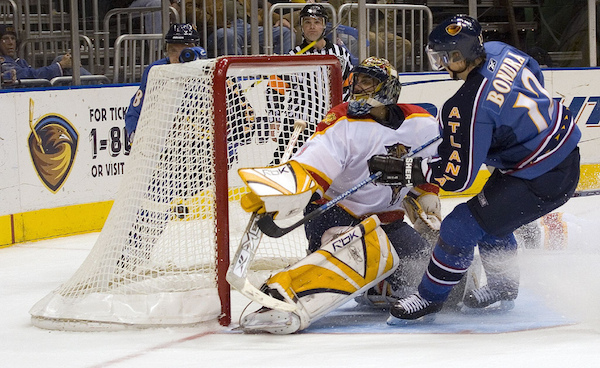Dear Sports Fan,
What is a power play in hockey?
Thanks,
Deborah
Dear Deborah,
Hockey has one of the more innovative ways of penalizing a player and a team for committing a foul. When a player commits a foul, a ref raises his arm, and as soon as a member of the player’s team gets control of the puck, the ref blows a whistle to stop play. The offending player is then escorted to a small, isolated compartment on the side of the rink opposite from where the teams sit, called the penalty box. Depending on the nature of the foul, he must remain there for some time, usually two or five minutes, or potentially until the other team scores a goal. While she is in the box, her team must play without her and they don’t get to simply replace her. They have to play shorthanded or “down a man,” which usually means they have four players plus a goalie against the other team’s five players plus a goalie. On rare occasions, one team may play with four players plus a goalie versus the other team’s three. Five on three is also possible, but the rules won’t allow things to get any more lopsided than that. The team that is has more players on the rink has a power play.
Power plays are extremely important in hockey because it is easier to score during one than in the normal course of “full strength” play. During a power play, the team with the extra player is often able to keep possession of the puck in their offensive zone and pass amongst themselves until they are able to get a good shot on goal. This is much more difficult without having the man advantage. Teams also have special combinations of players who they play during a power play. These units are, intuitively, called power play units. They’re usually made up of the best three offensive forwards on the team and the best two offensive defensemen although it’s not uncommon for a team to play with four forwards and one defenseman while they are on the power play. If a team choses to do this, one forward plays in the position a defenseman would normally be, up near the blue line that marks the dividing line between the offensive zone and the neutral zone. This gives the team more scoring punch on their power play unit but may also leave them vulnerable to a counter-attack.
20% is generally considered to be the dividing line between a good and a very good power play unit. A team that scores on more than 20% of their power play attempts is an extraordinarily good team with the man advantage. There are currently eight of the 30 NHL teams whose power play percentages are above 20%. Most of the rest of the teams range between 15% and 20% although there are three woeful teams that average a goal on less than 15% of their power play attempts. It’s no coincidence that two of these three teams have the two worst records in the league. It’s important to be good at converting power play attempts into goals.
When hockey games are at their most exciting and the stakes are at their highest, power plays begin to loom very large in fans’ minds. If your team is trailing, you hope desperately to be awarded a power play. If your team is winning, you just want the players on your team to play clean hockey and stay out of the penalty box. Once a penalty has been called, fans are launched into an even higher state of nervousness. If your team is the one with the power play, you barely make a sound for two minutes, except to scream pleadingly for a goal. If your team is the one that is shorthanded and killing the penalty off, then you just don’t breath until your team clears the puck away from their goal.
Power plays are wonderful theater and they’re also a great way to discourage foul play. I don’t know of many sports other than hockey that uses this type of deterrence (soccer has a similar rule for players who get red cards, but their banishment is permanent. I think water polo and possibly lacrosse have similar rules but with so many more players playing, the loss of one is less impactful) but I think more sports should adopt it. I recommended that football look into it during my epic series of articles on how to fix football’s brain injury problem. Until then, we’ll just keep enjoying it in hockey!
Hope this helps,
Ezra Fischer

